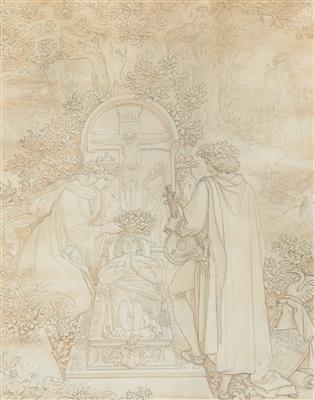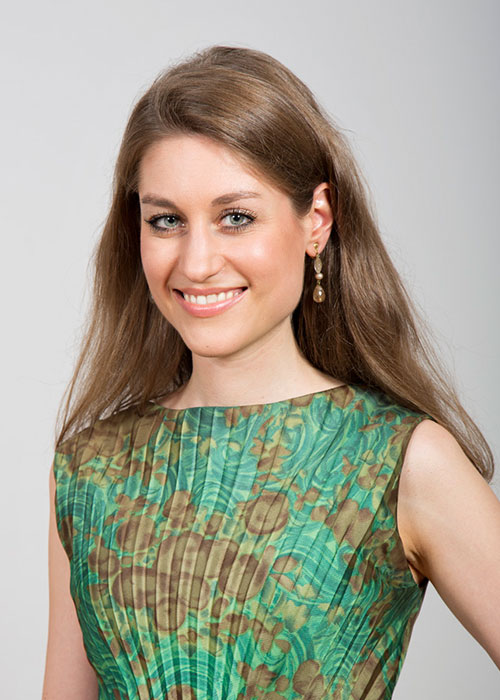Moritz von Schwind

(Vienna 1804–1871 Munich)
The tomb of Anton Ritter von Spaun, pencil, brown wash, on paper, 64 x 50 cm, mounted, framed, (Sch)
Provenance:
Private property, Austria.
Anton Ritter von Spaun died in 1849. Like his brother Joseph he was friends with Moritz von Schwind and one of the co-founders of the so-called Schubertiades. Moritz von Schwind may have intended the present drawing in preparation of a wall fresco, which should commemorate his deceased friend. The female figure ornating the grave with an oak leaf wreath may represent the personification of Upper Austria, which was the Austrian region where Spaun was born and had died. Spaun made a career in the service of the state. He was a municipal councillor and county commissioner and as a judge always retained links with his native region. Apart from his activities as a civil servant Spaun was also a historian, literary historian and a folklorist, who researched on folk songs and domestic poetry. He belonged to the Romanticist circle around Adalbert Stifter, Ernst von Feuchtersleben and Moritz von Schwind, who he was close friends with all of his lifetime. The male figure with the lute at the right is Heinrich von Ofterdingen who was a medieval poet and singer. In his treatise “Heinrich von Ofterdingen und das Nibelungenlied”. Ein Versuch den Dichter und das Epos für Austria zu vindicieren ” (Heinrich von Ofterdingen and the Nibelungenlied. An attempt to vindicate the poet and the poem for Austria), Spaun considered the medieval poet to descend from Austria. In Schwinds drawing an inscription plate right next to Ofterdingen at the righthand side points to it. Even though the historical existence and origin of Ofterdingen is not proven, Spaun became one of the most important figures of early Romantic poetry and was recognised in numerous works related to painting and poetry. The depiction of Ofterdingen mourning at the grave of Spaun does not only allude to the scientific debate about Ofterdingen but also acknowledges Spaun as a significant historian. The two grieving ladies in the background may represent Joseph von Spauns widow, Henriette, née von Vogelsang, and her daughter Marie, Edle von Spaun. Marie married Baron von Hagenauer on August 25th, 1851 and Moritz von Schwind was her best man.
The present drawing is one of several wellknown designs for the composition which Schwind may have executed in preparation for a fresco on a monument. An almost identical sepia drawing without the inscription “Anton Spaun Eqies Op Kremsmünster” on the grave stone and without the inscription plate right next to Heinrich von Ofterdingen is kept in a private collection in Karlsruhe (see Otto Weigmann, Moritz von Schwind: Des Meisters Werke in 1265 Abbildungen, Stuttgart / Leipzig 1906, p. 455) The present drawing is much richer in certain details such as in regard of the inscriptions and also in the vegetation. Its refinement recalls a later drawing „A nymph at a waterside tomb for Joseph Freiherr von Spaun” which is kept in Berlin today (Kupferstichkabinett, Inv. Nr. SZ Schwind 13, pen, brush and brown ink, watercolour, graphite, 39,5 x 27,4 cm). Joseph von Spaun was the brother of Anton and died in 1865, the year to which Weigmann dated the sepia drawing in Berlin when he illustrated it in his monograph on Schwind. Perhaps Schwind planned to conceive a print for both brothers.
We are grateful to Dr. Ulrike Olbrich for the scientific support.
Specialist: Mag. Astrid-Christina Schierz
 Mag. Astrid-Christina Schierz
Mag. Astrid-Christina Schierz
+43-1-515 60-546
astrid.schierz@dorotheum.at
20.10.2020 - 15:52
- Realized price: **
-
EUR 5,760.-
- Starting bid:
-
EUR 2,400.-
Moritz von Schwind
(Vienna 1804–1871 Munich)
The tomb of Anton Ritter von Spaun, pencil, brown wash, on paper, 64 x 50 cm, mounted, framed, (Sch)
Provenance:
Private property, Austria.
Anton Ritter von Spaun died in 1849. Like his brother Joseph he was friends with Moritz von Schwind and one of the co-founders of the so-called Schubertiades. Moritz von Schwind may have intended the present drawing in preparation of a wall fresco, which should commemorate his deceased friend. The female figure ornating the grave with an oak leaf wreath may represent the personification of Upper Austria, which was the Austrian region where Spaun was born and had died. Spaun made a career in the service of the state. He was a municipal councillor and county commissioner and as a judge always retained links with his native region. Apart from his activities as a civil servant Spaun was also a historian, literary historian and a folklorist, who researched on folk songs and domestic poetry. He belonged to the Romanticist circle around Adalbert Stifter, Ernst von Feuchtersleben and Moritz von Schwind, who he was close friends with all of his lifetime. The male figure with the lute at the right is Heinrich von Ofterdingen who was a medieval poet and singer. In his treatise “Heinrich von Ofterdingen und das Nibelungenlied”. Ein Versuch den Dichter und das Epos für Austria zu vindicieren ” (Heinrich von Ofterdingen and the Nibelungenlied. An attempt to vindicate the poet and the poem for Austria), Spaun considered the medieval poet to descend from Austria. In Schwinds drawing an inscription plate right next to Ofterdingen at the righthand side points to it. Even though the historical existence and origin of Ofterdingen is not proven, Spaun became one of the most important figures of early Romantic poetry and was recognised in numerous works related to painting and poetry. The depiction of Ofterdingen mourning at the grave of Spaun does not only allude to the scientific debate about Ofterdingen but also acknowledges Spaun as a significant historian. The two grieving ladies in the background may represent Joseph von Spauns widow, Henriette, née von Vogelsang, and her daughter Marie, Edle von Spaun. Marie married Baron von Hagenauer on August 25th, 1851 and Moritz von Schwind was her best man.
The present drawing is one of several wellknown designs for the composition which Schwind may have executed in preparation for a fresco on a monument. An almost identical sepia drawing without the inscription “Anton Spaun Eqies Op Kremsmünster” on the grave stone and without the inscription plate right next to Heinrich von Ofterdingen is kept in a private collection in Karlsruhe (see Otto Weigmann, Moritz von Schwind: Des Meisters Werke in 1265 Abbildungen, Stuttgart / Leipzig 1906, p. 455) The present drawing is much richer in certain details such as in regard of the inscriptions and also in the vegetation. Its refinement recalls a later drawing „A nymph at a waterside tomb for Joseph Freiherr von Spaun” which is kept in Berlin today (Kupferstichkabinett, Inv. Nr. SZ Schwind 13, pen, brush and brown ink, watercolour, graphite, 39,5 x 27,4 cm). Joseph von Spaun was the brother of Anton and died in 1865, the year to which Weigmann dated the sepia drawing in Berlin when he illustrated it in his monograph on Schwind. Perhaps Schwind planned to conceive a print for both brothers.
We are grateful to Dr. Ulrike Olbrich for the scientific support.
Specialist: Mag. Astrid-Christina Schierz
 Mag. Astrid-Christina Schierz
Mag. Astrid-Christina Schierz
+43-1-515 60-546
astrid.schierz@dorotheum.at
|
Buyers hotline
Mon.-Fri.: 10.00am - 5.00pm
kundendienst@dorotheum.at +43 1 515 60 200 |
| Auction: | Master Drawings, Prints before 1900, Watercolours, Miniatures |
| Auction type: | Online auction |
| Date: | 20.10.2020 - 15:52 |
| Location: | Vienna | Palais Dorotheum |
| Exhibition: | 14.10.2020 - 20.10.2020 |
** Purchase price incl. charges and taxes
It is not possible to turn in online buying orders anymore. The auction is in preparation or has been executed already.
